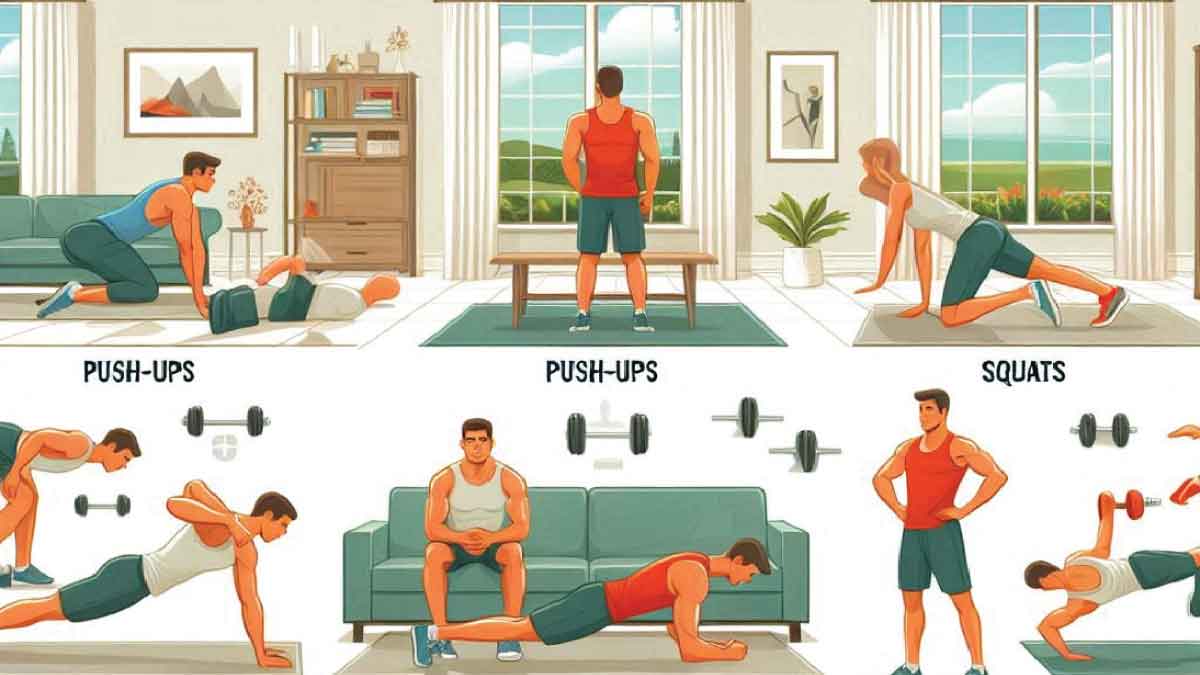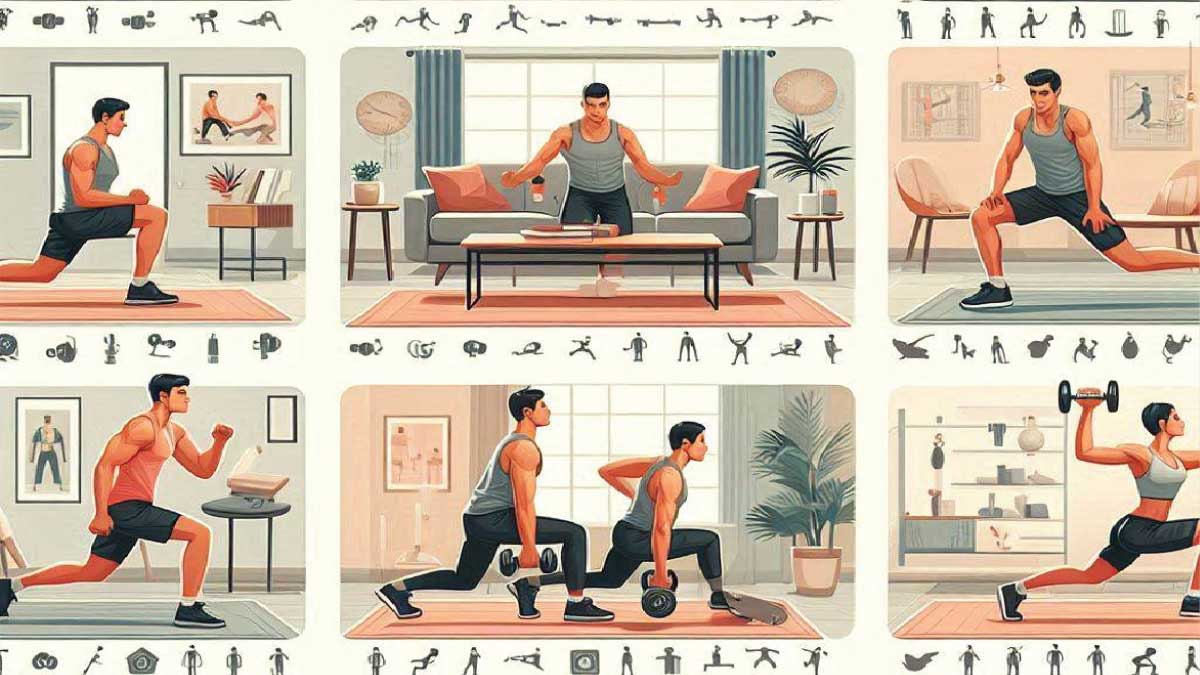Welcome to our comprehensive guide on fitness for beginners at home. In today’s fast-paced world, prioritizing health and fitness can often take a backseat due to busy schedules and other commitments. However, maintaining a regular fitness routine is crucial for overall well-being. Whether you are a complete novice or someone looking to transition from gym workouts to home exercises, this guide is tailored to help you kickstart your fitness journey from the comfort of your own home.
Understanding Fitness Basics
Before delving into specific exercises and routines, it’s essential to grasp the fundamentals of fitness. Fitness encompasses various components, including cardiovascular endurance, strength, flexibility, and balance. Each of these aspects plays a vital role in achieving overall physical health. By understanding these basics, you can tailor your workouts to target specific areas while ensuring a well-rounded approach to fitness.
Creating Your Home Workout Space
One of the perks of working out at home is the convenience of having your own dedicated exercise space. Whether you have a spare room, a corner of your living room, or even just a yoga mat in your bedroom, creating a designated area for exercise can help establish a routine and mindset conducive to fitness. Ensure your workout space is well-lit, clutter-free, and equipped with any necessary equipment or props for your chosen exercises.
Essential Equipment for Home Workouts
When it comes to home workouts, having the right equipment can make a significant difference in the effectiveness and enjoyment of your exercise routine. While bodyweight exercises are fantastic for building strength and endurance, incorporating basic fitness equipment can add variety and challenge to your workouts. Here are some essential items to consider adding to your home gym setup:
Dumbbells or Resistance Bands
Dumbbells and resistance bands are indispensable tools for home workouts. They are versatile and can target various muscle groups, allowing for a wide range of strength exercises. Whether you’re looking to tone your arms, strengthen your legs, or sculpt your core, dumbbells and resistance bands provide the resistance needed to challenge your muscles and promote growth and definition.
Yoga Mat
A quality yoga mat is a must have for anyone practicing floor exercises, yoga, or Pilates at home. Not only does it provide cushioning and support for your body during workouts, but it also creates a non-slip surface, ensuring stability and safety. A yoga mat can enhance your comfort and confidence, enabling you to focus on proper form and technique without worrying about slipping or discomfort.
Stability Ball
A stability ball, also known as an exercise or Swiss ball, is an excellent addition to any home gym. It’s particularly beneficial for core strengthening exercises, as it requires you to engage your abdominal and back muscles to maintain balance and stability. In addition to core work, a stability ball can be used to perform a variety of exercises targeting the upper and lower body, making it a versatile and effective piece of equipment.
Skipping Rope
Don’t underestimate the effectiveness of a simple skipping rope for cardio workouts. Skipping rope is an excellent way to elevate your heart rate, burn calories, and improve coordination and agility. It’s a low-cost, portable, and convenient tool that can be used indoors or outdoors, making it perfect for quick and effective cardio sessions. Whether you are a beginner or an experienced fitness enthusiast, adding skipping rope intervals to your workout routine can provide a fun and challenging cardiovascular workout.
By incorporating these essential pieces of equipment into your home gym setup, you can enhance the effectiveness and variety of your workouts, helping you reach your fitness goals more efficiently. Whether you’re focusing on strength, flexibility, or cardiovascular fitness, having the right tools at your disposal can make all the difference in your journey to a healthier, happier you.
Tailoring Your Workout Routine

When it comes to tailoring your workout routine for home fitness, it’s crucial to personalize it according to your specific needs, preferences, and lifestyle. Crafting a well-rounded routine that addresses all aspects of fitness – cardiovascular health, strength, flexibility, and recovery – is key to achieving optimal results and maintaining overall well-being.
Begin by assessing your fitness goals. Whether you aim to lose weight, build muscle, improve endurance, or enhance flexibility, your workout routine should be designed to support these objectives. Consider what motivates you and what types of exercises you enjoy, as this will increase the likelihood of sticking to your plan in the long term.
Next, take into account your time constraints and schedule. While it’s important to make time for exercise, it’s equally important to be realistic about what you can commit to on a regular basis. Opt for shorter, more frequent workouts if you have a busy schedule, or block out dedicated time slots for longer sessions if you have more flexibility in your day.
Now, let’s delve into crafting a sample beginner friendly workout plan that covers all the essential components of fitness:
Monday:
- Cardio: Start the week with 20 minutes of brisk walking or jogging. This helps to elevate your heart rate, burn calories, and improve cardiovascular health.
- Strength: Incorporate bodyweight squats into your routine. Aim for 3 sets of 10 reps each, focusing on proper form and controlled movements to target your lower body muscles effectively.
- Flexibility: Dedicate 5-10 minutes to a basic stretching routine. Focus on major muscle groups such as the hamstrings, quadriceps, calves, and upper body to improve flexibility and reduce the risk of injury.
Wednesday:
- Cardio: Mix it up with jumping jacks or skipping rope for 3 sets of 1 minute each. These high-intensity cardio exercises help to improve coordination, agility, and overall cardiovascular fitness.
- Strength: Integrate push-ups into your routine to target the chest, shoulders, and triceps. Aim for 3 sets of 8-10 reps, adjusting the difficulty level as needed by modifying hand placement or performing knee push-ups.
- Flexibility: Engage in a 20-30 minute yoga or Pilates session to enhance flexibility, balance, and core strength. Focus on flowing movements and deep breathing to promote relaxation and stress relief.
Friday:
- Cardio: Finish the week strong with high knees or mountain climbers for 3 sets of 1 minute each. These dynamic, full-body exercises help to boost metabolism, burn fat, and improve overall athletic performance.
- Strength: Incorporate dumbbell rows or resistance band exercises to target the back muscles. Aim for 3 sets of 10 reps per side, focusing on maintaining proper posture and controlled movements throughout.
- Flexibility: Wind down with foam rolling or mobility drills for 10-15 minutes. Foam rolling helps to release tension in tight muscles and improve range of motion, while mobility drills enhance joint mobility and flexibility.
By following this sample workout plan and customizing it to suit your individual needs and preferences, you can kickstart your fitness journey and gradually progress towards your goals. Remember to listen to your body, stay consistent, and celebrate your progress along the way.
Staying Motivated and Consistent
Maintaining consistency is paramount in the pursuit of fitness goals. Despite the inevitable hurdles and challenges along the way, sustaining motivation and dedication to your workout routine is crucial for achieving long-term success. Here are some effective strategies to help you stay on track and maintain momentum:
Set Realistic Goals:
Break down your overarching fitness aspirations into smaller, more manageable milestones. By setting achievable targets, you can maintain a sense of progress and momentum, which in turn keeps you motivated and focused on your journey to better health and fitness.
Find Enjoyable Activities:
Discovering activities that you genuinely enjoy can make sticking to your fitness routine much easier. Experiment with different types of exercises, whether it’s cycling, swimming, dancing, or hiking, until you find activities that resonate with you. When you genuinely enjoy what you’re doing, it becomes less of a chore and more of a rewarding experience, increasing your likelihood of consistency.
Track Your Progress:
Keeping track of your progress is essential for maintaining motivation and gauging your improvement over time. Consider maintaining a workout journal or using fitness apps to log your workouts, track your achievements, and monitor changes in your fitness level. Celebrate each milestone you achieve, whether it’s running a little farther, lifting heavier weights, or mastering a new yoga pose, as these small victories can fuel your motivation to keep pushing forward.
Stay Accountable:
Accountability can be a powerful motivator in sticking to your fitness routine. Partnering up with a workout buddy or joining online fitness communities can provide valuable support and encouragement. Sharing your goals and progress with others not only holds you accountable but also creates a sense of camaraderie and shared purpose, making your fitness journey more enjoyable and rewarding.
By incorporating these strategies into your approach to fitness, you can enhance your motivation, maintain consistency, and ultimately achieve your desired goals. Remember that progress takes time, and setbacks are a natural part of the process. Stay resilient, stay focused, and stay committed to your journey towards a healthier, happier you.
Conclusion About Fitness for Beginners at Home:
Embarking on a fitness journey is a thrilling endeavour, filled with excitement and challenges. However, with the correct mindset and approach, you can attain remarkable results from the comfort of your home. Understanding the fundamentals of fitness is crucial, as it allows you to tailor your workouts effectively and target specific areas of improvement. Creating a conducive workout environment in your home ensures that you have the space and equipment necessary to achieve your goals efficiently. Most importantly, maintaining consistency with your routine is key to long term success. By staying committed and dedicated to your fitness journey, you will experience improvements in your health, well-being, and overall quality of life.
FAQs about Home Workouts:
What are the benefits of doing home workouts?
Home workouts offer numerous benefits, including convenience, flexibility, and cost-effectiveness. You can exercise anytime, anywhere, without the need for a gym membership or commute. Additionally, home workouts allow for privacy and customization of routines to suit your preferences and schedule.
Do I need any equipment for home workouts?
While many effective exercises can be performed using only your body weight, incorporating basic fitness equipment can add variety and intensity to your workouts. Some essential items to consider include dumbbells or resistance bands, a yoga mat, a stability ball, and a skipping rope.
How can I stay motivated to exercise at home?
Staying motivated to exercise at home can be challenging, but there are several strategies you can try. Setting realistic goals, finding enjoyable activities, tracking your progress, and staying accountable by partnering up with a workout buddy or joining online fitness communities can help maintain motivation and consistency.
Are home workouts suitable for beginners?
Yes, home workouts are suitable for beginners. In fact, they can be an excellent way to start a fitness journey as they provide a comfortable and non-intimidating environment. It’s essential to begin with beginner-friendly exercises and gradually increase intensity as you build strength and confidence.
How often should I do home workouts?
The frequency of home workouts depends on your fitness goals, schedule, and individual preferences. As a general guideline, aim for at least 150 minutes of moderate-intensity aerobic activity or 75 minutes of vigorous-intensity activity per week, along with two or more days of strength training exercises targeting all major muscle groups. However, listen to your body and adjust the frequency as needed to avoid overtraining and allow for adequate rest and recovery.

